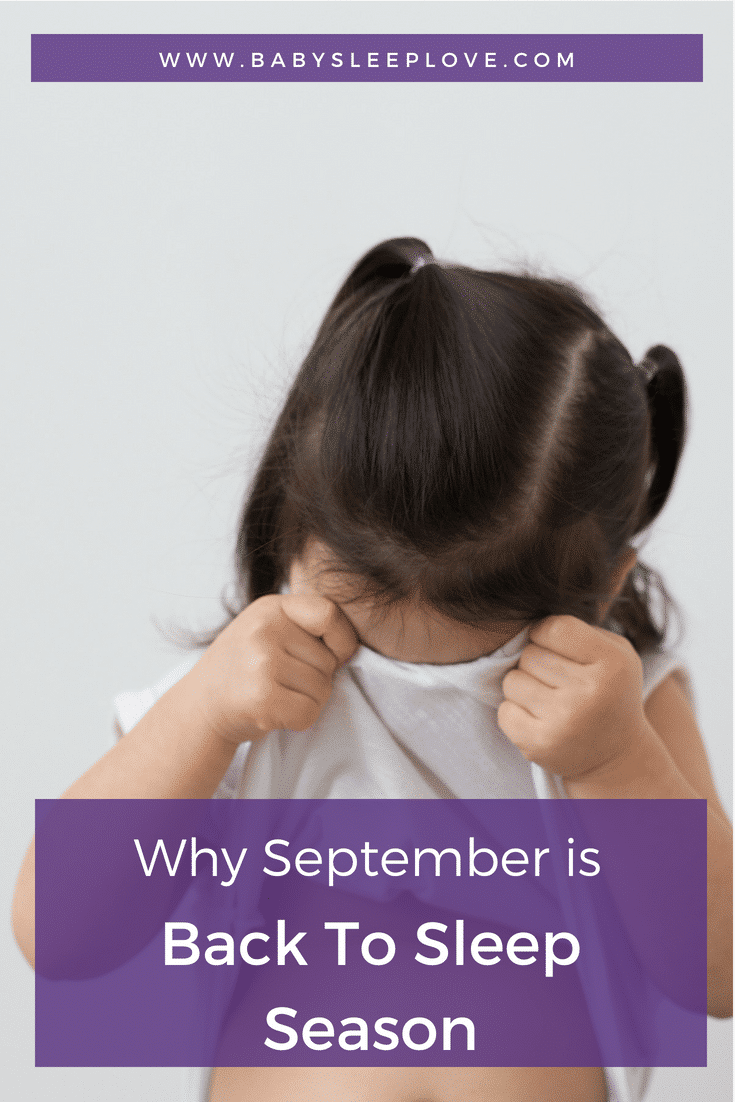September is the perfect month to start fresh with your little one’s sleep. For this reason, I’m calling it the Back to Sleep season. This is the time to let go of everything you thought you knew about sleep. And your expectations of how your baby, toddler or preschooler should be sleeping. It’s also the time to understand that if you want to see changes in their sleep, you will also need to make changes.
September always feels like a new beginning to me, even before my oldest started going to school. To me, it’s an even more impactful new beginning than New Year’s Day. This is probably because I always loved school. I’m truly a lifelong learner, and adore the sights and scents of a brand-new school year.
There are also some excellent reasons to embrace September as a new beginning for your child’s sleep.
It’s easier to achieve a perfectly sleep-conducive environment
A perfectly sleep-conducive environment is one where your efforts to encourage more independent sleep are less likely to be futile. It includes a dark and cool room (between 20-21 degrees Celsius, or 68-70 degrees Fahrenheit), with continuous white noise running. It should also have a “minimalist” look to the area in and around your little one’s bed.
With the days getting shorter during back to sleep season, you won’t have to do quite as much to get bedrooms dark. This increases your chance of success with settling down more easily and quickly at bedtime. It also means staving off those pesky early morning wakings (goodbye, garbage bags and duct tape!). With the temperatures cooling off, you won’t have to do quite as much to get bedrooms cool. This ensures that your little one can get the deep, restorative sleep they need. Additionally, this helps to prevent nightmares and night terrors, particularly for toddlers and preschoolers.
Less noise, less clutter
If you live in a more populated area like I do, your little one’s sleep is less likely to be interrupted in the fall when outdoor festivities and concerts significantly quiet down. Of course, I’d still highly encourage you to use continuous white noise (safely), to help block out any noise annoyances throughout the night and early morning and help your little one transition smoothly between sleep-wake cycles.
Finally, the new beginning of back to sleep season is the perfect time to invest in clearing the clutter. Babies sleep more soundly if the area around their crib is fairly “minimalist”, free from mobiles, toys and distracting piles of ‘stuff’ nearby. Even at the toddler and preschooler stage, a minimally-decorated bedroom and bed will do wonders for their sleep hygiene (and yours).
Back to sleep season is the perfect time to take stock and make changes
September is often the time when there are other changes happening in the household. For example, you might be returning to work after maternity or parental leave, putting your baby into daycare, or getting your toddler or preschooler into a preschool, nursery or other school environment.
While I don’t normally recommend making any major sleep habit changes at the same time as other major life changes (though there are some exceptions), it is the perfect time to look at your child’s overall sleep habits, sleep hygiene and needs in a more holistic way. What I mean by this – and all my clients will have heard me say this before 😉 – is that sleep is about much, much more than just sleep. It is about the 24-hour “day in the life of” your little one.
Ask yourself these questions to start taking stock:
- Is your little one getting enough outdoor air, light exposure and exercise?
- Are they getting enough social stimulation, i.e. meeting new people in new settings on a fairly regular basis?
- Are they getting too much stimulation? (Hint: Are they fussier or do they sleep more poorly after new experiences, or after certain activities?)
- Are their mealtimes consistent from day to day, if they’re feeding solids?
- Is your little one getting adequate sleep for their age group? (See here to check).
- Does your little one get enough wind-down time before naps and bedtime?
- Are you giving them a consistent bedtime routine from night to night that allows them to feel calm and relaxed and to understand what’s coming next (read: sleep)?
- Is their sleep schedule age-appropriate?
- Do they have the skills they need to fall asleep at nap time without distress if they’re in a daycare or other child minding arrangement?
- Do they have the skills they need to fall asleep within a reasonable amount of time at bedtime? I recommend aiming for no more than 15-20 minutes on any given night.
I could go on and on, but I’ll stop there. As you can see, there are a lot of variables that all work together to contribute to great sleep for your little one. Your first piece of homework is to scan this list and see where you can make some improvements. Once changes in the household have begun to solidify (give it 2-3 weeks), move on to making sleep habit changes.
One final check:
Finally, remember that a little one with rock-solid independent sleep skills will always fare far better with life changes, schedule changes, weather and seasonal shifts!
Happy sleeping, parents!
Join Baby Sleep Love on Facebook and Instagram.
Craving some step-by-step, personalized help with teaching your toddler to fall asleep on their own, and sleep through the night? I’ve got you covered! Take a look at our packages here to see how we can help.
